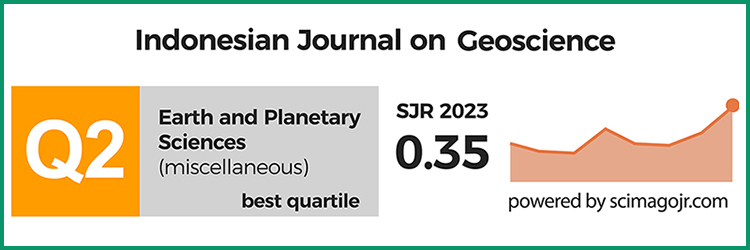Geochemical Evaluation and Pore Type Characterization of Carbonaceous Rich Facies in Brown Shale Formation, Central Sumatra Basin
DOI:
https://doi.org/10.17014/ijog.7.2.121-133Abstract
DOI:10.17014/ijog.7.2.121-133
Brown Shale Formation of Pematang Group is a key source rock in the Central Sumatra Basin. The formation consists of three lithofacies: algal rich facies, mixed algal-carbonaceous facies, and carbonaceous rich facies. This paper focuses on evaluating the geochemistry and on characterizing the porosity of the carbonaceous rich facies. Geochemical evaluation of the carbonaceous source rocks was conducted using Rock-Eval pyrolysis, while mineralogy and microtextural characterization were assessed by incident light microscopy and scanning electron microscopy (SEM). The results show that the organic components of the carbonaceous source rocks are predominantly composed of vitrinite with minor inertinite and liptinite. The geochemical characteristics indicate that the carbonaceous rich facies could be ranked as a good to excellent level in terms of source rock potential with high TOC content, mainly containing kerogen type III as a gas prone potential. SEM results show that the pore types in the carbonaceous source rocks can be classified into three main types: porous floccules, organic-porosity, and intraparticle pores. Thus, the carbonaceous rich facies of the Brown Shale Formation contains gas prone source rocks with good generation potential, as well as organic rich shale unconventional reservoirs.
References
Caineng, Z.O.U., Rukai, Z.H.U., Shizhen, T.A.O., Lianhua, H.O.U., Xuanjun, Y., Yan, S., and Guosheng, Z., 2013. Unconventional Petroleum Geology, 500pp.
Clarke, M.C.G., Kartawa, W., Djunuddin, A., Suganda, E., and Bagdja, M., 1982. Geological Map of the Pakanbaru Quadrangle, Sumatra, scale 1:250.000. Geological Research and Development Centre, Indonesia.
Daidu, F., Yuan, W., and Min, L., 2013. Classifications, sedimentary features and facies associations of tidal flats. Journal of Palaeogeography, 2 (1), p. 66-80. DOI:10.3724/SP.J.1261.2013.00018.
Espitalié, J., Marquis F., and Sage L., 1987. Organic geochemistry of the Paris Basin. In: Brooks, J. and Glennie, K. (eds.), Petroleum Geology of North West Europe, Graham and Totman, London, p.71-86.
Guo, X., Li, Y., Liu, R., and Wang, Q., 2014. Characteristics and controlling factors of micro-pore structures of Longmaxi Shale Play in the Jiaoshiba area, Sichuan Basin. Natural Gas Industry, 34 (6), p.9-16. DOI: 10.3787/j.issn.1000-0976.2014.06.002.
Heidrick, T.L. and Aulia, K., 1993. A structural and tectonic model of the Coastal Plains Block, Central Sumatra Basin, Indonesia. Proceedings of Indonesian Petroleum Association, 22nd Annual Convention, Jakarta, 1, p.285-317.
Hwang, R.J., Heidrick, T., Mertani, B., Qivayanti, and Li, M., 2002. Correlation and migration studies of North Central Sumatra oils. Organic Geochemistry, 33 (12), p.1361-1379. DOI:10.1016/S0146-6380(02)00104-3.
Katz, B.J. and Dawson, W.C., 1997. “Pematang - Sihapas Petroleum System of Central Sumatra”. Proceedings of an International Conference on Petroleum Systems of SE Asia and Australasia, p.685-698.
Lafargue, E., Marquis, F., and Pillo,t D., 1998. Rock-Eval applications in hydrocarbon exploration, production, and soil contamination studies. Oil & Gas Science and Technology, 53, p.421-437.
Löhr, S.C., Baruch, E.T., Hall, P A., and Kennedy, M.J., 2015. Is organic pore development in gas shales influenced by the primary porosity and structure of thermally immature organic matter? Organic Geochemistry, 87, p.119-132. DOI:10.1016/j.orggeochem.2015.07.010.
Longley, I.M., Barraclough, R., Bridden, M.A, and Brown, S., 1990. Pematang lacustrine petroleum source rocks from the Malacca Strait PSC, Central Sumatra, Indonesia. Proceedings of Indonesian Petroleum Association, 19th Annual Convention, p.279-297.
Loucks, R.G., Reed, R.M., Ruppel, S.C., and Hammes, U., 2010. Preliminary Classification of Matrix Pores in Mudrocks. Gulf Coast Association of Geological Societies Transactions, 60 (2), p.435-441.
Mazied, M., Amin, S., and Irawan, C., 2008. Source Investigation of Oils Discovered in the West Kampar Block, Central Sumatra Basin. Proceedings of Indonesian Petroleum Association, 37th Annual Convention, p.1-12.
Nichols, G., 2009. Sedimentology and Stratigraphy. Wiley-Blackwell Publishing Company, Chichester, West Sussex, United Kingdom, 432pp.
Robinson, K.M. and Kamal A., 1988. Hydrocarbon Generation, Migration and Entrapment in the Kampar Block, Central Sumatra. Proceedings of Indonesian Petroleum Association, 17th Annual Convention, p.211-256.
Rock, N.M.S., Aldin, D.T., Aspden, J.A., Clarke, M.C.G., Djunuddin, A., Kartawa, W., Miswar., Thomson, S.J., and Whandoyo, R., 1983. Geological Map of the Lubuksikaping Quadrangle, Sumatra, scale 1:250.000. Geological Research and Development Centre, Indonesia.
Rodriguez, N. and Philp, R.P., 2015. Source rock facies distribution predicted from oil geochemistry in the Central Sumatra Basin, Indonesia. American Association of Petroleum Gelogists, Bulletin, 99 (11), p.2005-2022.
Standards Australia, 1998. Coal petrographymaceral analysis. Australian Standards 2856- 2, 32pp.
Wain, A.S. and Jackson, B.A., 1995. New Pematang Depocentres on The Kampar Uplift, Central Sumatra. Proceedings of Indonesian Petroleum Association, 24th Annual Convention, I”.
Williams, H.H. and Eubank, R.T., 1995. Hydrocarbon habitat in the rift graben of the Central Sumatra Basin, Indonesia. Geological Society, London, Special Publications, 80 (1), p.331-371. DOI:10.1144/GSL.SP.1995.080.01.16.
Williams, H.H., Kelley P.A., Jank J.S., and Christensen R.M., 1985. The Paleogene Rift Basin Source Rocks of Central Sumatra. Proceedings of Indonesian Petroleum Association, 14th Annual Convention, p.57-90.



















